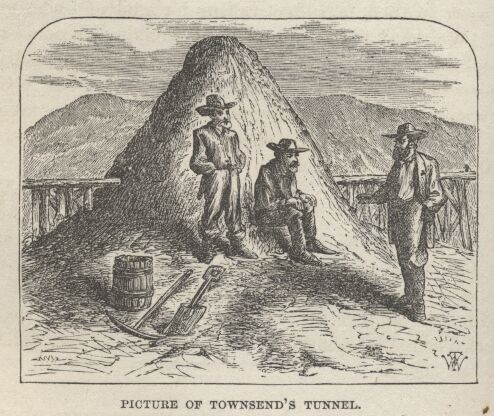"We put our names to it and tried to feel that our fortunes were made. But when we talked the matter all over with Mr. Ballou, we felt depressed and dubious. He said that this surface quartz was not all there was of our mine; but that the wall or ledge of rock called the “Monarch of the Mountains,” extended down hundreds and hundreds of feet into the earth—he illustrated by saying it was like a curb-stone, and maintained a nearly uniform thickness-say twenty feet—away down into the bowels of the earth, and was perfectly distinct from the casing rock on each side of it; and that it kept to itself, and maintained its distinctive character always, no matter how deep it extended into the earth or how far it stretched itself through and across the hills and valleys. He said it might be a mile deep and ten miles long, for all we knew; and that wherever we bored into it above ground or below, we would find gold and silver in it, but no gold or silver in the meaner rock it was cased between. And he said that down in the great depths of the ledge was its richness, and the deeper it went the richer it grew. Therefore, instead of working here on the surface, we must either bore down into the rock with a shaft till we came to where it was rich—say a hundred feet or so—or else we must go down into the valley and bore a long tunnel into the mountain side and tap the ledge far under the earth. To do either was plainly the labor of months; for we could blast and bore only a few feet a day—some five or six. But this was not all. He said that after we got the ore out it must be hauled in wagons to a distant silver-mill, ground up, and the silver extracted by a tedious and costly process. Our fortune seemed a century away!
But we went to work. We decided to sink a shaft. So, for a week we climbed the mountain, laden with picks, drills, gads, crowbars, shovels, cans of blasting powder and coils of fuse and strove with might and main. At first the rock was broken and loose and we dug it up with picks and threw it out with shovels, and the hole progressed very well. But the rock became more compact, presently, and gads and crowbars came into play. But shortly nothing could make an impression but blasting powder.
That was the weariest work! One of us held the iron drill in its place and another would strike with an eight-pound sledge—it was like driving nails on a large scale. In the course of an hour or two the drill would reach a depth of two or three feet, making a hole a couple of inches in diameter. We would put in a charge of powder, insert half a yard of fuse, pour in sand and gravel and ram it down, then light the fuse and run. When the explosion came and the rocks and smoke shot into the air, we would go back and find about a bushel of that hard, rebellious quartz jolted out. Nothing more. One week of this satisfied me. I resigned. Clagget and Oliphant followed. Our shaft was only twelve feet deep. We decided that a tunnel was the thing we wanted."
"So we went down the mountain side and worked a week; at the end of which time we had blasted a tunnel about deep enough to hide a hogshead in, and judged that about nine hundred feet more of it would reach the ledge. I resigned again, and the other boys only held out one day longer. We decided that a tunnel was not what we wanted. We wanted a ledge that was already “developed.” There were none in the camp.
We dropped the “Monarch” for the time being."
(Roughing It)
 Williams writes that Twain was partners in six claims, the Horatio and Derby, the Black Warrior, the Flyaway, the Dashaway, the Monitor and the Annipolitan. In mid-May his Monitor claim was jumped. In early June the suit against the jumpers was settled in court but he was forced to give a portion of the claim to the jumpers. As for the Annipolitan, thought to be his most promising claim, it was discovered to be part of the Pride of Utah claim and Twain lost all rights to it.
Williams writes that Twain was partners in six claims, the Horatio and Derby, the Black Warrior, the Flyaway, the Dashaway, the Monitor and the Annipolitan. In mid-May his Monitor claim was jumped. In early June the suit against the jumpers was settled in court but he was forced to give a portion of the claim to the jumpers. As for the Annipolitan, thought to be his most promising claim, it was discovered to be part of the Pride of Utah claim and Twain lost all rights to it.